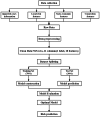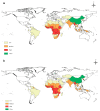Risk assessment of imported malaria in China: a machine learning perspective
- PMID: 38509529
- PMCID: PMC10956205
- DOI: 10.1186/s12889-024-17929-9
Risk assessment of imported malaria in China: a machine learning perspective
Abstract
Background: Following China's official designation as malaria-free country by WHO, the imported malaria has emerged as a significant determinant impacting the malaria reestablishment within China. The objective of this study is to explore the application prospects of machine learning algorithms in imported malaria risk assessment of China.
Methods: The data of imported malaria cases in China from 2011 to 2019 was provided by China CDC; historical epidemic data of malaria endemic country was obtained from World Malaria Report, and the other data used in this study are open access data. All the data processing and model construction based on R, and map visualization used ArcGIS software.
Results: A total of 27,088 malaria cases imported into China from 85 countries between 2011 and 2019. After data preprocessing and classification, clean dataset has 765 rows (85 * 9) and 11 cols. Six machine learning models was constructed based on the training set, and Random Forest model demonstrated the best performance in model evaluation. According to RF, the highest feature importance were the number of malaria deaths and Indigenous malaria cases. The RF model demonstrated high accuracy in forecasting risk for the year 2019, achieving commendable accuracy rate of 95.3%. This result aligns well with the observed outcomes, indicating the model's reliability in predicting risk levels.
Conclusions: Machine learning algorithms have reliable application prospects in risk assessment of imported malaria in China. This study provides a new methodological reference for the risk assessment and control strategies adjusting of imported malaria in China.
Keywords: China; Imported Malaria; Machine learning; Random Forest; Risk Assessment; Risk mapping; Risk prediction.
© 2024. The Author(s).
Conflict of interest statement
The authors declare no competing interests.
Figures





Similar articles
-
[Risk predictive models of healthcare-seeking delay among imported malaria patients in Jiangsu Province based on the machine learning].Zhongguo Xue Xi Chong Bing Fang Zhi Za Zhi. 2023 Jun 28;35(3):225-235. doi: 10.16250/j.32.1374.2022290. Zhongguo Xue Xi Chong Bing Fang Zhi Za Zhi. 2023. PMID: 37455092 Chinese.
-
Imported malaria from land bordering countries in China: A challenge in preventing the reestablishment of malaria transmission.Travel Med Infect Dis. 2023 May-Jun;53:102575. doi: 10.1016/j.tmaid.2023.102575. Epub 2023 Apr 24. Travel Med Infect Dis. 2023. PMID: 37100163 Free PMC article.
-
Deep learning hybrid model for analyzing and predicting the impact of imported malaria cases from Africa on the rise of Plasmodium falciparum in China before and during the COVID-19 pandemic.PLoS One. 2023 Dec 6;18(12):e0287702. doi: 10.1371/journal.pone.0287702. eCollection 2023. PLoS One. 2023. PMID: 38055693 Free PMC article.
-
Preparation for malaria resurgence in China: approach in risk assessment and rapid response.Adv Parasitol. 2014;86:267-88. doi: 10.1016/B978-0-12-800869-0.00010-X. Adv Parasitol. 2014. PMID: 25476888 Review.
-
Ready for malaria elimination: zero indigenous case reported in the People's Republic of China.Malar J. 2018 Aug 29;17(1):315. doi: 10.1186/s12936-018-2444-9. Malar J. 2018. PMID: 30157876 Free PMC article. Review.
References
-
- Cao CL, Guo JG. Challenge and strategy of prevention and control of important parasitic diseases under the Belt and Road Initiative[J] Chin J Schistosomiasis Control. 2018;30(02):111–6. - PubMed
-
- World Health Organization., World Malaria Report(2020).
Publication types
MeSH terms
Grants and funding
LinkOut - more resources
Full Text Sources
Medical

